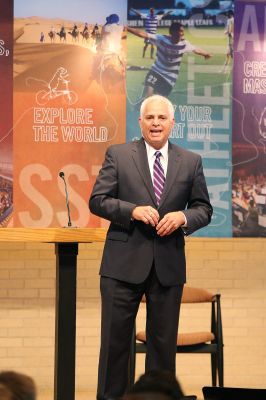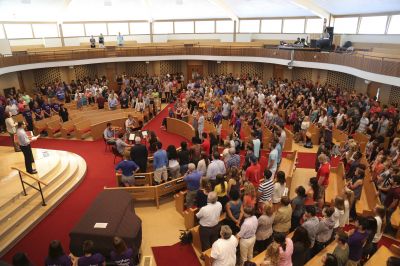President’s speech: “Citizens of Earth and Sky"

Fall Opening Convocation message, delivered by Dr. James E. Brenneman, President of Goshen College, on Wednesday, Aug. 27, 2014, in the Goshen College Church-Chapel (as prepared for delivery)
Related link:

View photos from the applause tunnel following the opening convocation
EACH YEAR WE FOCUS on one core value for the year. This year, all year, we will ponder the meaning of the core value, “global citizenship.”
At Goshen College, we have expressed the core value, global citizenship, primarily in two ways. The first and most common understanding has to do with our desire to foster “intercultural openness” between people of differing worldviews, experiences and ethnicities. For 120 years, GC has honed these people-to-people border crossing instincts, first sending alums and faculty around the world in mission endeavors of all kinds, then in the birth of Study-Service Term (SST), and more recently, embedding this impulse into our core curriculum while working to transform our campus and recruitment efforts to carry out the vision of becoming a truly intercultural and international liberal arts college reflective of the diversity in our region, our church and the world around us. A primary understanding of global citizenship is that of people-to-people diplomacy and intercultural relationships.
It’s the second understanding of what the core value global citizenship means that I wish to focus on today. In some ways, this understanding should be the basic one; it’s meaning should take precedence over every other consideration because it presupposes every other form of global citizenship there is. To be a global citizen in its most radical form, at root, “in the beginning,” at the source, in its most primal understanding, is to be a citizen of the earth and sky. To be a global citizen first and foremost is to desire to experience, understand and steward the many and varied multi-cultures (the bio-diversity) of the natural world around us.
——
I want to suggest three postures for becoming citizens of earth and sky:
First, to be a global citizen in its truest sense, we must become the animals we were born to be. By this I do not mean becoming John “Bluto” Blutarsky of Animal House fame, the drunken degenerate in his seventh year of college with a GPA of 0.0. What I mean is, we must somehow regain the gift of “paying heed to our directly felt experience” of life throbbing and pulsating around and through us. David Abram in his wonderful book, Becoming Animal, calls such intimacy with creation the recovery of an “earthly cosmology.”
The incarnation of God into material flesh, a central tenet of Christian faith, should remind us that this so-called “animal body” of ours is a blessing. God declared it very good. Indeed, for all its vulnerabilities, our human fleshly body remains the primary instrument of our knowing, just as the whimsical earth remains our primary cosmos. Actually, it is probably most truly the case that our primal sense of being animal, our fleshy self-awareness and emergent feelings of transcendence are the first fruits of later notions of godly incarnations to begin with, and not the other way around. The special, but natural revelation of creation, in fact, precedes all special revelations to come providing the base line for their understanding, however profound they may be.
I so enjoy long conversations with Professor Emeritus of Art, Dr. Abner Hershberger, whether in his home-studio, over coffee and dessert, or almost anywhere else. Professor Hershberger uses the French term métier to describe vocations of perception, different ways we each have of perceiving the world around us. Abner goes on to describe the artistic impulse, the immediate awareness and undiluted experience of art, in almost primal terms. He worries a bit that too often our inherited métier or conceptual framework, our intellectual rumination about matter, and shapes, and things, and theology and, yes even our intellectual rumination about art, simply isolate us from the intimacy of the experience of light and shadow, of color and shape.
When most of us look at a shadow, for example, we see it simply as a flat two-dimensional shape on the pavement or on a wall. Deeper awareness reveals that the shadow truly creates a three-dimensional zone between my body and the ground, or in a larger arena a three-dimensional shadow between a mountain slope and the ground before it. In the three-dimensional space there awakens a previously hidden but lively ecosystem, a mosquito-laced, mossy-laden, dampened-air cosmos that isn’t present to us in the full sun. Sitting in Dr. Hershberger’s home with its panoramic windows overlooking the glittery, sun-dappled woods, one can see and feel the moment by moment changes that happen as the sun slowly moves across the sky. Each degree creates a whole new living masterpiece.
Another way I experience this immediacy of nature, believe it or not, is on a motorcycle. Robert Pirsig in his Zen and the Art of Motorcycle Maintenance: An Inquiry into Values, is right when he says, “In a car you’re always in a compartment, and because you’re used to it you don’t realize that through that car window everything you see is just more TV. You’re a passive observer and it is all moving by you boringly in a frame. On a cycle the frame is gone. You’re completely in contact with it all. You’re in the scene, not just watching it anymore, and the sense of presence is overwhelming.” I say “Amen!” to that. It truly is an awesome experience to enter the shadows of a line of trees across a country road and feel the temperature drop immediately and then rise just as fast as you pass through or to come in and out of subtle smell-zones usually unnoticed in a car. I commend it to you as a metaphysical experience, indeed.
And then there’s the revelation of kindness in nature that precedes all later acts of human kindness by millions of years. A whole series of recent scientific studies have shown that kindness is an instinct that has been honed and blessed by nature in nature and must serve as a prophetic critique of Darwin’s one-sided violent aphorism: “nature, red in tooth and claw.” Be it whales passing through huge “automatic” whale-wash schools of cleaner fish, or fire burning down forests as a gift to new life or dead and dying trees creating living loam to thicken the woods and filter the trickling brooks, these studies of nature’s many kindnesses, all draw similar conclusions: the more we connect with the natural world (say with our pets), the kinder and healthier we actually do become. Creation, it seems, has conditioned us with immense capacity to mimic its many kindnesses.
——-

To be an earth citizen, a global citizen, then, we must, first and as often as possible, become animal-like in our senses and relationship to the earth and sky. Secondly, then, as citizens of earth and sky, we must also learn how better to eavesdrop on creation, to listen to and learn from “the rocks and trees, the skies and seas” and everything in between.
As earth citizens, we must learn to appreciate how late we humans have come to the party of creation. If millions of eons before any human being was formed or shaped in creation, God and nature at table sat down, what might have that conversation been like? What might we hear God say to us as we hold a conch shell to our ear in the middle of Indiana, or in the desert for that matter, and hear the echo of a billion gallons of ocean whispering to us? What might a thousand species of microbes living on and inside us say to us about interdependency, diversity and survival? What might the wind-scaffold unfolding beneath an eagle’s spread wings in a thousand-foot vertical drop say to faint, weary-worn-walkers on planet earth?
It should not strike us as all that odd, then, that Jesus once taught his disciples to trust in God by listening to what the sparrows or the lilies of the field might teach us. Nor should we think odd that the Book of Proverbs points to the lowly ant as a prime example of the value of hard work or that the Psalmist notices the trees of the field clap their hands, that the hills and mountains shout for joy, that the sun, moon and stars declare the glory of God. And what about that talking donkey and devilish serpent?
The new interdisciplinary field of science, engineering and technology called biomimicry is a wonderful example of eavesdropping on creation. It’s also another example of scientific modesty. These engineers are proving creation has much to teach us, if we listen. They are trying to imitate nature’s best ideas to solve human problems. Stop and think about it for a minute. In the structure of the tree, countless millennia of natural engineering has gone into creating an amazing system of hydraulics that brings water up from the ground against gravity to the tippy-top of a tree with what seems like little or no effort. We have no comparable human-made system of hydraulics that is as simple and effective as that of trees. Would that we could imitate a tree, no?
More encouraging, today, mimicking nature has helped to create non-toxic adhesives inspired by how a gecko sticks to the ceiling or mollusks adhere to rock underwater. I had the privilege of hearing the billionaire industrialist Ray Anderson speak a few years back. He described how he overhauled his whole carpet manufacturing business called Interface, to provide non-toxic, green-inspired carpets, his design borrowed straight out of nature. His carpets line the halls of our Student Apartments and other places on campus, also. Self-cleaning surfaces on high-rises without the use of detergents have now been built that mimic the self-cleaning surface of a lotus leaf. And on and on it goes.
A bio-diverse and multi-cultured natural world is the key to the earth’s survival and that of our own. The more species of animal or plant we kill off or lose, we are potentially losing out on the solution to a complex human problem just waiting to be solved. Perhaps, it’s time to “quiet human cleverness,” a bit, to learn from God’s cleverly designed universe. Global citizens need to listen to what creation is telling us.
——
Third, earth and sky citizens are called to paint the world green. At GC, we have 50 shades of green and more. A green GC is a core value worthy of our deep and abiding commitment as global citizens.
As just one of two presidents in Indiana to sign the American College and University President’s Climate Commitment Initiative eight years ago, our goal was simply to reduce our carbon footprint, to reduce carbon emissions that threaten the planet’s ecosystems, its economy and our very lives.
As of last year, we voluntarily began purchasing all of our electricity from renewable energy sources, such as wind and solar power reducing our carbon footprint by 45 percent. Because of our commitments, we actually pay less and consume less energy overall than ever before even though our physical footprint is larger than it was 25 years ago. Our Ecological Stewardship Committee – guided by Glenn Glibert, GC’s Sustainability Coordinator, along with many students and faculty and staff – have led us to greener pastures, whether from recycling efforts, cleanup of the nearby Elkhart River, purchasing eco-friendly furniture, carpeting and custodial supplies, building a solar powered water heater for the Rec-Fitness Center showers, turning some 10 acres on campus into native gardens, using 700-plus monitors all over campus to regulate our light, gas, a/c, heating usage.
And, of course, the crown jewel of GoGreen Goshen is the Merry Lea Environmental Learning Center, “where earth and people literally do meet” day in and day out. These and many more examples are expressions of our deep commitment to the core value of being global citizens, citizens of earth and sky. We are grateful to have been acknowledged recently by the Sierra Club as among the top ‘cool’ colleges for environmental stewardship. To be named the third best Christian college AND among the top green colleges in the nation in the same month is a beautiful testimony to the breadth and depth that this year’s core value has at a Jesus-centered liberal arts institution like Goshen College.
——
In the spirit of our core value of becoming global citizens, citizens of the earth and sky, I will let creation have the last word. Since the dawn of time, every culture has told a version of the story of the dying and rising of the sun. The sun goes down in the west and rises in the east. Nature induced the question in us: “How does the sun get from one side of the world to the other?” Some stories answered that question by claiming the sun must travel (perhaps, on a boat) under the earth, fighting off chthonian deities and principalities of darkness – sort of like Harry Potter fighting the Basilisk in the hollows of the Chamber of Secrets – and just in time, with barely a minute to spare, the sun rises on the other side to the east.
The story resonates with us, even today, even though we know since Copernicus, that it is the earth that moves around the sun, while the sun stays still. From this métier, from this perceptual experience, the ancient cycle of the dying and rising sun gave birth to every other dying and rising, death and resurrection, story that has ever been told. Once again, it was first the natural, special revelation of creation that provided the mental structures to even understand the concept of resurrection that is so key to understanding the later Christ-story.
Creation first proclaimed loudly and clearly that darkness will not last; that even if the sun goes down, even it sinks beneath the sea at the end of the world, even if it hides beneath the earth for a while, it inevitably rises again. It is this story that I hope will resonate with you today, as it does me. Creation is blessing you and me with a promise that no matter the difficulty, the hardship, the pain, no matter the circumstance, the darkness, no matter what trouble may come, the sun will rise again and so can you. In that heavenly sign, I am confident.




